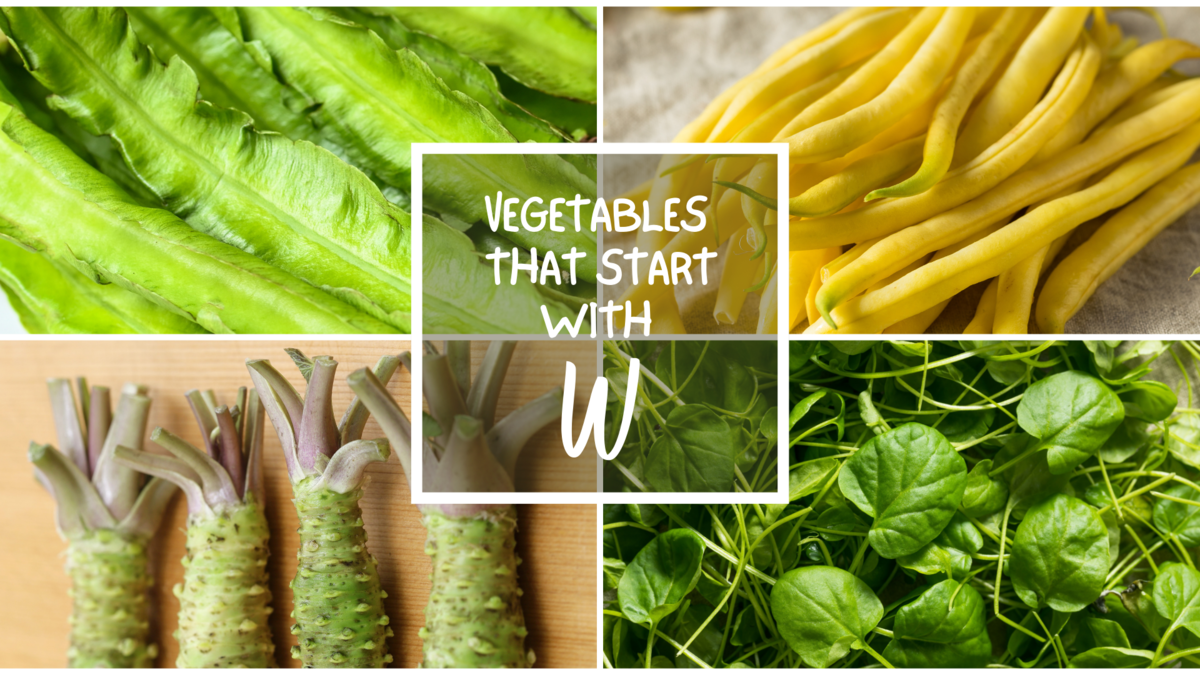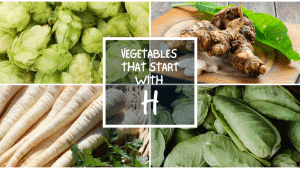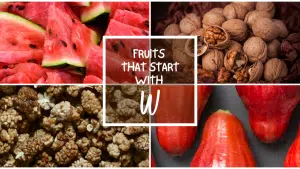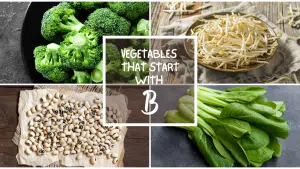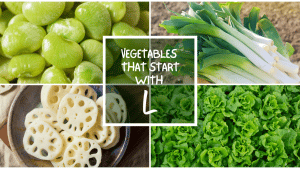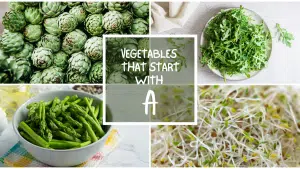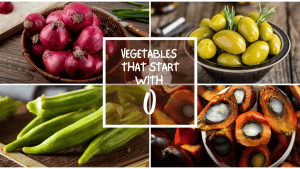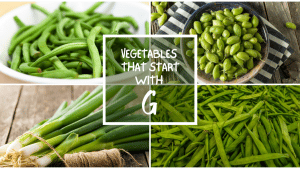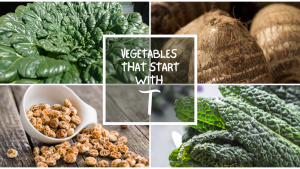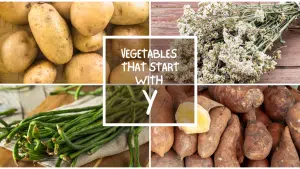All The Vegetables That Start With W
Important Note: When you buy through our links, we may earn a commission. As an Amazon Associate we earn from qualifying purchases. Content, pricing, offers and availability are subject to change at any time - more info.
Have you ever been interested in trying out some new vegetable recipes? Here is a compiled list of all the vegetables that start with W to help you out in your grocery shopping. Knowledge of the comprehensive health benefits and recipes of different vegetables available in the market is a step to healthy living. This detailed compilation of all vegetables that start with W should quench your quest for rich flavor and taste.
- Wasabi
- Water Caltrop
- Water Spinach
- Welsh Onion
- Wild Leek
- Winged Beans
- Wax Beans
- White Radish
- Wild Garlic
- Watercress
- Wheatgrass
- Wild Endive
- Winter Gourd
- The Final Letter
Wasabi

The scientific name of wasabi is Eutrema japonicum. This plant belongs to the mustard family and is native to South Korea, Japan, and Russia. The wasabi plant has specific growing requirements, thus limiting its cultivation. They are highly-priced and found in limited stock in America.
Wasabi roots are first washed and then peeled using a knife. Grind the wasabi roots finely to make a thick green paste. To preserve the flavor, make sure you cover the paste before using it or use it within the first few hours after grinding.
Wasabi vegetable paste is an excellent accompaniment to sashimi and sushi dishes. This paste is also used as a top dressing on grilled meat. You can use the wasabi root and combine it with cucumbers, avocado, and little vinegar to make a rich salad. These vegetables can also be added to soups and stews to give a rich taste.
Wasabi contains Vitamin C, which promotes healthy hair growth and maintains the elasticity of the skin. These vegetables have anti- hypercholesterolemia properties that reduce your risk of strokes and heart disease. Wasabi also has traces of Vitamin B6, which is critical in producing serotonin hormone that can influence moods and reduce depression symptoms.
Water Caltrop

The scientific name for water caltrop is Trapa. This is a floating aquatic plant native to the temperate regions of Asia, North Africa, and Europe. This plant is also commonly known as waternoot or Jesuit nut. These plants thrive in flooded fields and calm freshwater bodies.
Water caltrops are medium irregular-shaped pods with two dropping spines that are curved and elongated. The pods are tough and turn from green to purple-black with smooth skin. Inside the pods is a large fibrous seed. The caltrop pods have a rusty earthly odor.
The water caltrop is considered toxic when raw, requiring it to be cooked before consumption. The seeds of the caltrop are dry, sweet, and with a mild flavor of musk.
Water chestnuts are rich in Potassium, which protects you from cardiovascular diseases like heart attack by lowering your blood pressure. These vegetables also contain ferulic acid, an antioxidant that reduces your risk of growing cancer cells. Water chestnuts are rich in Vitamin B6, which can improve the quality of your sleep and uplift your mood by lowering your stress levels.
Water Spinach
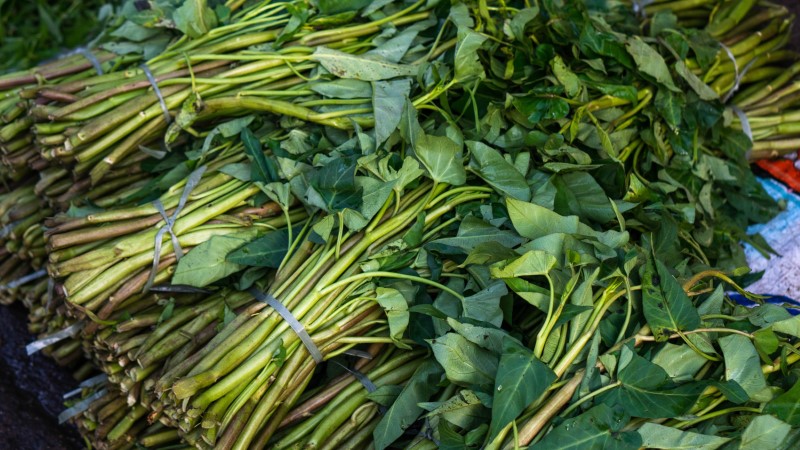
The scientific name of water spinach is Ipomoea aquatica. These vegetables are native to India, Sri Lanka, Thailand, and Central and South China. Water spinach is tolerant to frost and commonly grows in freshwater habitats like ponds, lakes, marshes, canals, and stream banks. However, the water spinach is considered illegal vegetation in the United States.
Water spinach is a long, green leafy vegetable growing in water with hollow stems. These vegetables are different from spinach but belong to the morning glory family. Other common names to refer to it are river spinach, Chinese spinach, or swamp spinach.
Water spinach can be stir-fried with garlic and salt, and add some ginger to enjoy the sweetness. You can also stir-fry these vegetables with ginger. Water spinach can be fermented to give the vegetables a wine-soaked flavor.
Water spinach is packed with high water and fiber content essential in maintaining a healthy gut by reducing indigestion and constipation. These vegetables also contain Vitamin C, which helps boost the immune system and protect the body from frequent diseases and infections. Iron present in water spinach is critical in producing red blood cells and in treating and preventing anemia.
Welsh Onion

The scientific name for welsh onion is Allium fistulosum. These veggies originated in south china and are grown in the East Asia countries like Japan, Korea, and China. The other names of welsh onions are long green onions and bunching onions.
Welsh onions are small in size and grow in straight elongated leaves with a slender, narrow base. These leaves are of a smooth texture with stiff, hallow, and small tubes at the center. Welsh onions are juicy and crispy with a mildly sweet, grassy, and slightly savory.
Welsh onions are washed, sliced into small pieces then combined with other vegetables to make salads. These onions best maintain their flavor if eaten fresh. You can add the welsh onions into soups and stews or cut them into pieces and add them atop baked potatoes with butter. Remember not to cook these onions; add them later when the cooking of the meals is done.
Welsh onion contains Vitamin C and K, which are essential in developing strong bones and repairing broken bones. These vegetables also contain folic acid, which promotes the healthy growth and development of the fetus in pregnant women. Welsh onions are rich in iron, which prevents and helps treat anemia by stimulating red blood cell formation.
Wild Leek
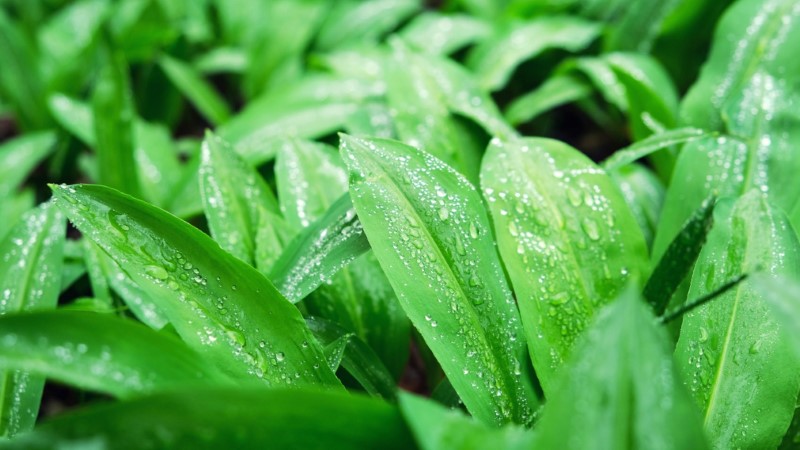
The scientific name for wild leek is Allium tricoccum. These plants are native to the Northern and Eastern mountains of America. Wild leeks are native to Asia and Europe and grow in patches in moist regions of the forests in North Canada, North Carolina, and Tennessee. The other common names are wood leek, wild garlic, and ramps.
Wild leeks have leaves that are large, broad, and open. These vegetables have a taste that reminiscence a cross breed between garlic and onion but with some sweetness.
You can eat the wild leeks raw, cooked, or pickled. These vegetables are often added to salad recipes. The wild leeks can also be used in soups, pasta, and stir-fries. Another unique recipe is to dehydrate them and grind them to powder used to season dishes.
Wild leek contains carotenoids, which promote healthy eyes by reducing your risk of cataracts and macular degeneration due to age. These vegetables are rich in Vitamin K, which is essential in building strong and dense bones. Antioxidants in the wild leek vegetables can repair damaged DNA and lower your chances of growing cancer cells.
Winged Beans
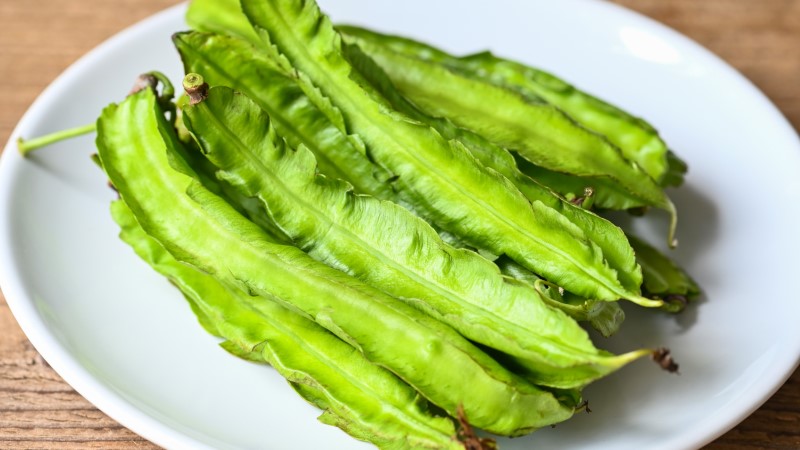
The scientific name for the winged bean is Psophocarpus tetragonolobus. These leguminous veggies thrive in hot- humid equatorial regions. The winged beans are found growing in Asia and Papua & New Guinea. Commonly known as princess beans and goa beans, winged beans are also found scarcely cultivated in Florida in the United States.
Winged beans are unique in appearance, with four distinctive wing-like corners. At the center of these corners is contained a small seed. These beans have a subtle flavor with light crunchiness. The winged beans have a taste like green peas and snow peas.
The young wing beans can be eaten raw in salads. You wash the beans, snap the stem off and slice them into your desired size before adding them to other vegetables. However, these beans are commonly cooked in vegetable dishes when mature. You can mix the wing beans with garlic, oil, salt, water, and corn starch to make winged bean garlic stir fry.
Winged beans are rich in Vitamin K and A, which are good immune boosters giving your body resistance to dealing with disease and infections. These legumes also contain fiber and calcium, which helps build strong bones and promote the general health of the digestive tract. Calcium and Vitamin D in the winged beans help you reduce the risk of diabetes by stimulating the production and distribution of insulin that help regulate the blood sugar levels.
Wax Beans

The scientific name for wax beans is Phaseolus vulgaris. Other common names are field bean and kidney bean. Wax beans are native to Central Mexico and Guatemala. They are mainly found in tropics, sub-tropics, and temperate regions.
Wax beans are a type of beans similar in taste to green beans but with a bright yellow color. These beans have a rich and slightly sweet taste with a crunchy snap texture when ripe. To know if the beans are overdue, check for limp pods.
Wax beans can be added to make soups, salads, and pasta dishes. You can use these beans as a substitute in green bean recipes. In contrast to common beans, the wax beans have a pleasant color that you can mix with green beans to bring out a nice visual appeal.
Wax beans contain carbs which provide the body with the energy needed to function properly. Fibers in these beans are beneficial in regulating blood sugar levels and preventing constipation. These legumes have traces of iron, which is essential in the treatment and prevention of anemia by helping produce new red blood cells. Vitamin C, which is responsible for boosting the immune is present in wax beans.
White Radish
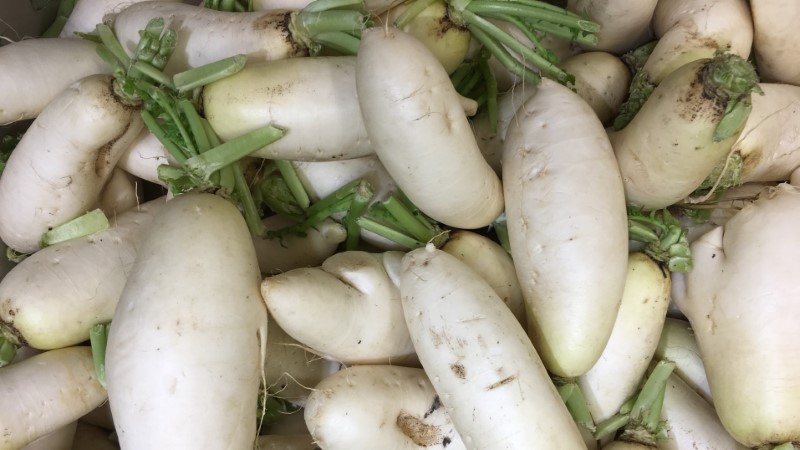
The scientific name of white radish is Raphanus sativus var. Longipinnatus. These vegetables are native to China and have spread to other regions like Egypt, Europe, and Mexico. In the United States, you can find the radish easily in Florida and California. Other names are Japanese radish and winter radish.
White radish has a similar shape to a carrot but with a different color. This plant offers both its leaves and roots as vegetables, with the roots being more common. When eaten raw, the white radish is a bit bitter.
Radish is crunchy and peppery. The young leaves are eaten raw and form a perfect choice for making salads. You can also chop the leaves and add them to sandwiches or cook them like spinach. When cooked, these vegetables don’t get soggy and maintain their crunch, making them well suited to making Asian-style pickles and stir-fries.
These vegetables are high in fiber, preventing constipation and promoting perfect bowel movement. White radish is also home to vitamin B and C, which are essential in promoting the development of healthy elastic skin and hair growth. Calcium and Potassium in these vegetables prevent heart diseases by lowering your blood pressure; protecting you from strokes.
Wild Garlic

The scientific name of wild garlic is Allium ursinum. Wild garlic is native to Europe and Asia and is commonly known as wood garlic or broad-leaved garlic. They are widespread in eastern Canada and the eastern United States.
Wild garlic is a green leafy bulbous perennial plant related to the common garlic. This type of garlic has mild garlic and a chive-like onion smell. The plant has broad, deep green and pointed leaves. This plant offers its leaves, flowers, and cloves as edible vegetables.
The young leaves, seed pods, and flowers can be added to salads alongside other vegetables. The flower stems are also used like chives. You can use the bigger leaves like spinach by wilting them or use them as dressings. The wild garlic is also a good accompaniment if added to stews, soups, or smeared on top of grilled meat and fish.
Garlic contains anti-bacterial and anti-fungal compounds, which can help calm bloating, inflammation, constipation, and other stomach issues by re-balancing the bacterial flora in the gut. Garlic also has essential minerals that are beneficial to the arteries and can help prevent atherosclerosis by dealing with the cholesterol levels in the body. Garlic is also crucial in maintaining good heart health and lowering your risk of strokes and heart attacks.
Watercress

The scientific name of the watercress is Nasturtium officinale. Watercress is found in sub-Sahara Africa, the Caribbean, East and Southeast Asia, Australia, New Zealand, and some Pacific Islands. These plants rapidly colonize small waterways and streams. Watercress can grow in shallow waters or be found submerged in freshwater and are less tolerant to frost and dry conditions.
Watercress is a perennial aquatic herb that has white cross-shaped flowers. These vegetables have a peppery taste which disappears when cooked. When cooked, the watercress takes a tastier vegetable flavor in soups and stews. However, the mature watercress can have a slightly bitter taste.
To maintain the peppery green flavor of these vegetables, use them raw in salads. The watercress salads can be served solo or combined with other vegetables. You can chop these vegetables and add them to mayo to make a sauce that can be served over poached salmon. The watercress can be blended with oil, parsley, cheese, and nuts to make a sauce called pesto.
Watercress contains Vitamin C, which is essential in keeping you healthy by boosting your immune and reducing your chances of getting infections and diseases. These vegetables have traces of Potassium, magnesium, and calcium minerals which are essential in the formation and maintenance of strong, healthy bones. These vegetables also contain Vitamin A, which improves your vision by maintaining healthy retinas.
Wheatgrass
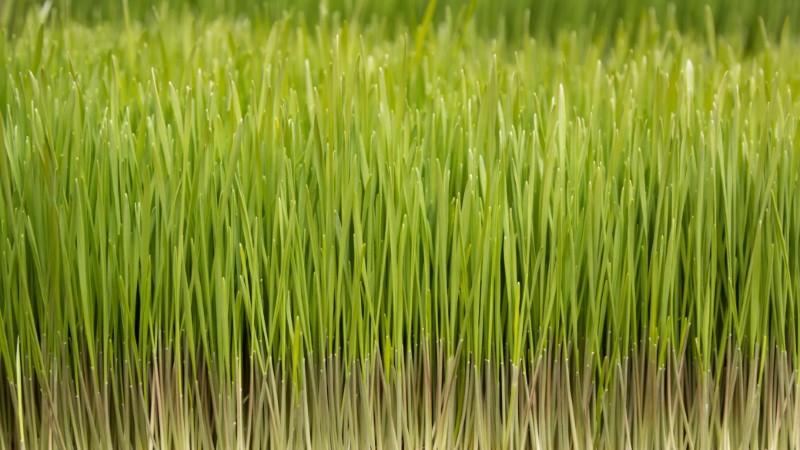
The scientific name of wheatgrass is Thinopyrum intermedium. Wheatgrass is common throughout the North Temperate Zone. The other names include common wheat bread wheat.
You should consider taking the wheatgrass raw to benefit from its nutrients. The wheatgrass is dehydrated and crushed into a powder that can be added to sauces and stews. The wheatgrass powder can be added to vegetable or fruit salads and sprinkled on top of a final barbecue glaze. This green powder is also a good ingredient that can be added to smoothies, puddings, or yogurt and served as a breakfast drink.
The taste of wheatgrass is dependent on several conditions. These vegetables adopt an unpleasant bitter taste when grown indoors because of mold growth. Outdoor-grown wheatgrass has a milder flavor. When harvested late or overstayed in stores, the wheatgrass has a bitter taste.
Wheatgrass is rich in enzymes and essential amino acids that fight the harmful toxins in the body and boost your immunity. Selenium minerals in these vegetables are crucial in maintaining the proper functioning of the thyroid glands and help you maintain a good weight by reducing your cravings to eat food constantly. Wheatgrass vegetables boost fertility by promoting the production of reproductive hormones and increasing stamina through increasing blood flow to the sex organs.
Wild Endive
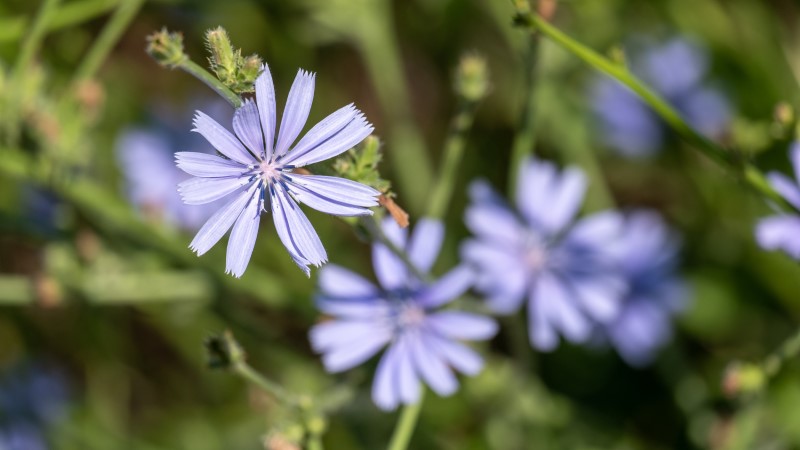
The scientific name of wild endive is Cichorium intybus. These plants are found in Eastern Mediterranean, India, and Central Europe and are known as common Chicory. Wild endive thrives in the tropics like Malaysia, the Philippines, and central and West Africa.
Raw endives have a bitter taste that sweetens and becomes nutty when cooked. Wild endives can be eaten raw or cooked. These vegetables make a base for salads because of their bitter flavor and sturdy texture. Endives work well with hummus dips and are a good substitute for chips because of their crunchiness. These vegetables can be roasted, braised, seared, or grilled.
Wild endive is rich in Vitamin A, which is vital in maintaining good vision and preventing age-related macular degeneration maintaining good vision at night. These vegetables are also rich in fibers, which help keep stable blood sugar levels by slowing the digestion process. Wild endive veggies are beneficial to expectant mothers because of their richness in folic acid, which reduces the chances of congenital disabilities, thus maintaining healthy pregnancies.
Winter Gourd

The scientific name of the winter gourd is Benincasa hispida. Other common names are ash pumpkin, wax gourd, and winter melon. Winter gourd is native to Southeast Asia and commonly grown in Java and Japan.
Winter gourds are large fruits with a mild sweetness used as vegetables in most Indian and Asian recipes. You can grill, roast, simmer, boil or steam the winter gourd. This gourd is commonly added to stir-fries, stews, curries, soups, and cake pies.
Winter gourds are never to be consumed raw. To prepare this vegetable, remove the skin and seeds before cooking. However, the gourd becomes mushy when overcooked. Always lightly cook the fruit.
Water guards are high in water and soluble fiber content, which help improve digestion and promote the feeling of fullness by slowing the digestion of food. Flavonoids and carotenes antioxidants in these veggies protect the body from type 2 diabetes, heart disease, and cell damage. Water gourd contains Vitamin C, which is essential in maintaining general wellness by boosting immunity.
The Final Letter
It is fascinating to realize how vast the vegetable world is. Exploring the vegetable world will give you a great experience that you will forever remember. This list of all vegetables that start with W is a good top-up for vegetable explorers.
